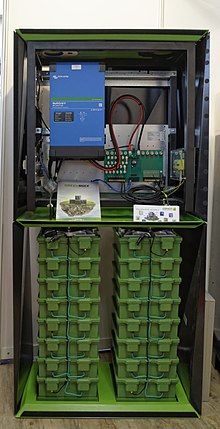 A sodium-ion cell (size 18650) | |
| Specific energy | 0.27-0.72 MJ/kg (75–200 W·h/kg) |
|---|---|
| Energy density | 250–375 W·h/L |
| Cycle durability | "thousands"[1] of cycles |
| Nominal cell voltage | 3.0-3.1 V |
Sodium-ion batteries (NIBs, SIBs, or Na-ion batteries) are several types of rechargeable batteries, which use sodium ions (Na+) as their charge carriers. In some cases, its working principle and cell construction are similar to those of lithium-ion battery (LIB) types, but it replaces lithium with sodium as the intercalating ion. Sodium belongs to the same group in the periodic table as lithium and thus has similar chemical properties. However, in some cases, such as aqueous batteries, SIBs can be quite different from LIBs.

SIBs received academic and commercial interest in the 2010s and early 2020s, largely due to lithium's high cost, uneven geographic distribution, and environmentally-damaging extraction process. An obvious advantage of sodium is its natural abundance,[2] particularly in saltwater. Another factor is that cobalt, copper and nickel are not required for many types of sodium-ion batteries, and more abundant iron-based materials (such as NaFeO2 with the Fe3+/Fe4+ redox pair) [3] work well in Na+ batteries. This is because the ionic radius of Na+ (116 pm) is substantially larger than that of Fe2+ and Fe3+ (69–92 pm depending on the spin state), whereas the ionic radius of Li+ is similar (90 pm). Similar ionic radii of lithium and iron result in their mixing in the cathode material during battery cycling, and a resultant loss of cyclable charge. A downside of the larger ionic radius of Na+ is a slower intercalation kinetics of sodium-ion electrode materials.[4]
The development of Na+ batteries started in the 1990s. After three decades of development, NIBs are at a critical moment of commercialization. Several companies such as HiNa and CATL in China, Faradion in the United Kingdom, Tiamat in France, Northvolt in Sweden,[5] and Natron Energy in the US, are close to achieving the commercialization of NIBs, with the aim of employing sodium layered transition metal oxides (NaxTMO2), Prussian white (a Prussian blue analogue[6]) or vanadium phosphate as cathode materials.[7]
Sodium-ion accumulators are operational for fixed electrical grid storage, but vehicles using sodium-ion battery packs are not yet commercially available. However, CATL, the world's biggest lithium-ion battery manufacturer, announced in 2022 the start of mass production of SIBs. In February 2023, the Chinese HiNA Battery Technology Company, Ltd. placed a 140 Wh/kg sodium-ion battery in an electric test car for the first time,[8] and energy storage manufacturer Pylontech obtained the first sodium-ion battery certificate[clarification needed] from TÜV Rheinland.[9]
- ^ Cite error: The named reference
faradionwas invoked but never defined (see the help page). - ^ Abraham, K. M. (2020). "How Comparable Are Sodium-Ion Batteries to Lithium-Ion Counterparts?". ACS Energy Letters. 5 (11): 3544–3547. doi:10.1021/acsenergylett.0c02181.
- ^ Xie, Man; Wu, Feng; Huang, Yongxin (2022). Sodium-Ion Batteries. doi:10.1515/9783110749069. ISBN 978-3-11-074906-9.
- ^ Gaddam, Rohit R.; Zhao, George (2023). Handbook of Sodium-Ion Batteries. doi:10.1201/9781003308744. ISBN 978-1-003-30874-4.
- ^ Lawson, Alex. "'Breakthrough battery' from Sweden may cut dependency on China". The Guardian. Retrieved 22 November 2023.
- ^ Maddar, F. M.; Walker, D.; Chamberlain, T. W.; Compton, J.; Menon, A. S.; Copley, M.; Hasa, I. (2023). "Understanding dehydration of Prussian white: from material to aqueous processed composite electrodes for sodium-ion battery application". Journal of Materials Chemistry A. 11 (29): 15778–15791. doi:10.1039/D3TA02570E. S2CID 259615584.
- ^
- Yadav, Poonam; Shelke, Vilas; Patrike, Apurva; Shelke, Manjusha (2023). "Sodium-based batteries: Development, commercialization journey and new emerging chemistries". Oxford Open Materials Science. 3. doi:10.1093/oxfmat/itac019.
- Yadav, P.; Patrike, A.; Wasnik, K.; Shelke, V.; Shelke, M. (2023). "Strategies and practical approaches for stable and high energy density sodium-ion battery: A step closer to commercialization". Materials Today Sustainability. 22. Bibcode:2023MTSus..2200385Y. doi:10.1016/j.mtsust.2023.100385.
- "Chapter 6 the commercialization of sodium-ion batteries". Sodium-Ion Batteries. 2022. pp. 306–362. doi:10.1515/9783110749069-006. ISBN 978-3-11-074906-9.
- Rudola, Ashish; Coowar, Fazlil; Heap, Richard; Barker, Jerry (2021). "The Design, Performance and Commercialization of Faradion's Non-aqueous Na-ion Battery Technology". Na-ion Batteries. pp. 313–344. doi:10.1002/9781119818069.ch8. ISBN 978-1-78945-013-2.
- Hijazi, Hussein; Desai, Parth; Mariyappan, Sathiya (2021). "Non-Aqueous Electrolytes for Sodium-Ion Batteries: Challenges and Prospects Towards Commercialization" (PDF). Batteries & Supercaps. 4 (6): 881–896. doi:10.1002/batt.202000277.
- Barker, Jerry (2019). "(Invited) the Scale-up and Commercialization of a High Energy Density Na-Ion Battery Technology". ECS Meeting Abstracts: 64. doi:10.1149/ma2019-03/1/64.
- Deng, Jianqiu; Luo, Wen-Bin; Chou, Shu-Lei; Liu, Hua-Kun; Dou, Shi-Xue (2018). "Sodium-Ion Batteries: From Academic Research to Practical Commercialization". Advanced Energy Materials. 8 (4). Bibcode:2018AdEnM...801428D. doi:10.1002/aenm.201701428.
- Bauer, Alexander; Song, Jie; Vail, Sean; Pan, Wei; Barker, Jerry; Lu, Yuhao (2018). "The Scale-up and Commercialization of Nonaqueous Na-Ion Battery Technologies". Advanced Energy Materials. 8 (17). Bibcode:2018AdEnM...802869B. doi:10.1002/aenm.201702869.
- ^ Hina Battery becomes 1st battery maker to put sodium-ion batteries in EVs in China, CnEVPost, 23 February 2023
- ^ "Pylontech Obtains the World's First Sodium Ion Battery Certificate from TÜV Rheinland". 8 March 2023.